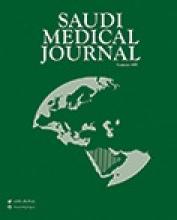To the Editor
I have read with interest the paper “Recent incidence and descriptive epidemiological survey of breast cancer in Saudi Arabia” published by Saggu et al1 in the October 2015 issue of Saudi Medical Journal. In this paper, the authors reported a frequency profile of breast cancer (BC) in the Kingdom of Saudi Arabia (KSA) for almost 2 decades indicating that the cancer increased over time in this region of the Middle East. It does not, however, seem to be realistic to conclude a decreasing or increasing time trend based on these absolute figures derived from the Saudi Cancer Registry (SCR) and King Faisal Specialist Hospital and Research Centre in Riyadh, KSA.
In epidemiological studies, time trends are measured using prevalence and incidence rates rather than frequencies. Incidence measures the risk probability of health conditions (such as, diseases, and so forth) in a population within a specified period of time. This is the number of new cases within a specified time period divided by the size of the population initially at risk of the condition (such as, diseases, and so forth). For instance, if a population initially contains 100,000 non-diseased (but at risk) individuals with 120 persons who develop the condition over a year while they were under the risk, the incidence is 1.2 cases (per 1000 persons) in this population. The concept and measurement of prevalence rate is, however, quite different of incidence. The prevalence is the proportion of all cases, either new or previous ones, in a population at a given time. Thus, the incidence rate is the risk of contracting the disease, whereas the prevalence shows the magnitude of the disease.2
Reply from the Author
In our study,1 an integrative literature scrutiny was undertaken in order to obtain the latest information/pattern of all BC reports of female patients from 1979 onwards in KSA. The SCR of KSA is a population-based registry established in 1992 under the jurisdiction of the Ministry of Health by the order of His Excellency the Minister of Health. The SCR publishes an annual cancer incidence report. We understand the concept and measurement of prevalence rate is quite different as that of incidence. Increased awareness and efficient BC information-dissemination campaign led to an increased number of diagnosed cases of BC. Breast cancer in KSA is the most common cancer in women. The SCR reported a rising proportion of BC among women of all ages, from 10.2% in 2000 to 24.3% in 2005.3 In 2011, the registry of King Faisal Specialist Hospital and Research Centre reported that the number of BC cases has increased considerably.
An important limitation of the study was its retrospective nature, although our study covered a large area, all the data were from SCR and the hospital, which is why they might not be representative of the entire KSA. There is a need for a larger study involving various medical centers that would also examine other environmental, genetic, and dietary factors that may contribute to the incidence of breast diseases in this part of the world. Breast cancer was the ninth leading cause of death for females in KSA in 2010. Moreover, it is expected that the incidence of BC will increase over the coming decades in KSA due to the population’s growth and aging.4 Breast cancer awareness activities are currently widespread in KSA; knowledge about the disease is still very low among women. The advances in technology and messaging should be used to reach women everywhere.
The KSA is in need of female role models to improve the health of its female population. Indeed, it was shown that awareness campaigns based solely on advertising are not enough to produce mass screening and increase mammography in other Middle Eastern countries. Therefore, our review focuses on the recent BC occurrences and its pattern in KSA.
Shalini Saggu
Department of Biology, Faculty of Sciences, University of Tabuk, Tabuk, Kingdom of Saudi Arabia
- Copyright: © Saudi Medical Journal
This is an open-access article distributed under the terms of the Creative Commons Attribution-Noncommercial-Share Alike 3.0 Unported, which permits unrestricted use, distribution, and reproduction in any medium, provided the original work is properly cited.






